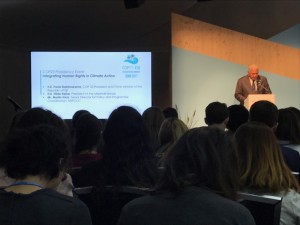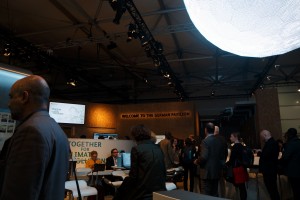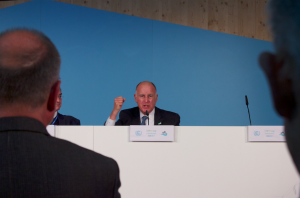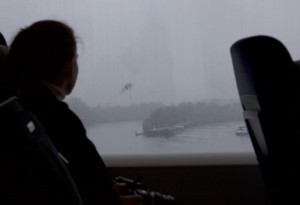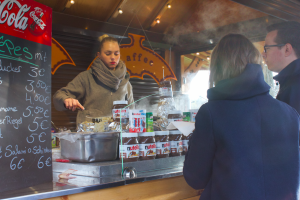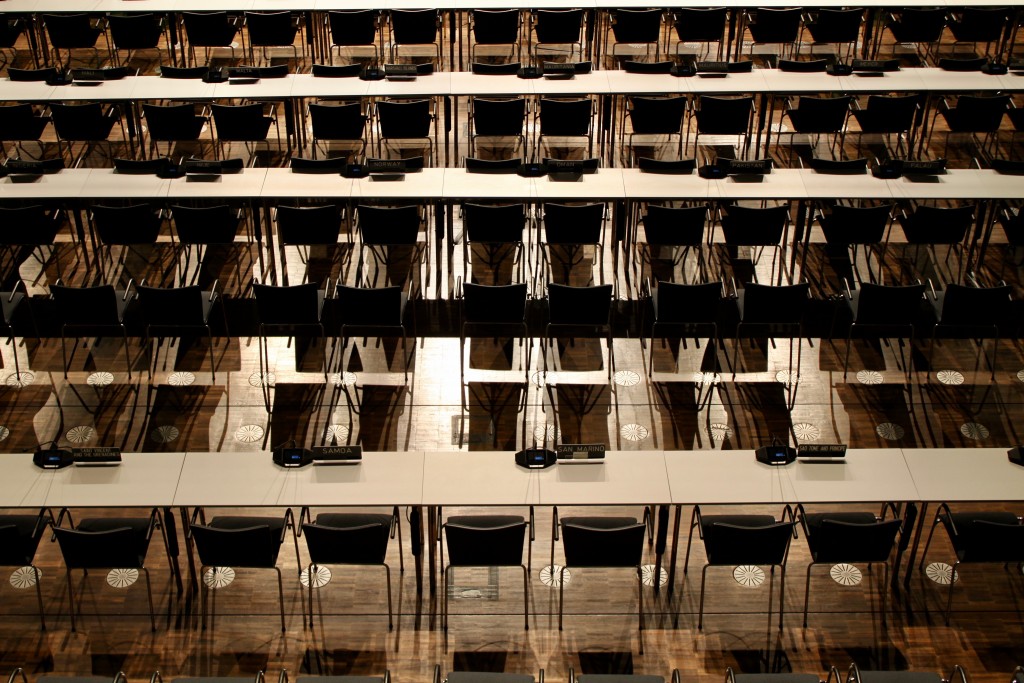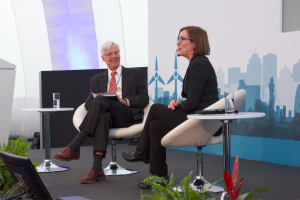
Governor Kate Brown of Oregon, a powerful woman, speaking about the climate policies she has successfully implemented in her state.
Today was the COP 23 Gender Day, a day meant to “highlight how gender-responsive climate policy and action can provide economic benefits to communities and create opportunities for raising ambition under national climate plans, while transforming lives, particularly of women and girls”. Before getting into my observations from Gender Day at COP23, I’ll go into a little background information on gendered climate issues.
The 2013 COP conference was the first year that the disproportionate affect of environmental degradation on women was recognized on a large-scale. The initial title was “Women’s Day” and it intended to highlight women’s involvement in environmental issues and provide women with a larger platform to voice their issues and empower themselves. The title “Women’s Day” was changed to “Gender Day” because focusing on women instead of gendered power structures depicted women as victims, furthering their subjugation in the matter.
I’m sometimes met with confusion or skepticism when I say women feel the impacts of climate change more than men. However, women and children are fourteen times more likely to die in ecological disasters than men. Greta Gaard provides interesting case studies in her article “Ecofeminism and Climate Change” (2015),
“...women and children are 14 times more likely to die in ecological disasters than men (Aguilar, 2007; Aguilar, Araujo, & Quesada-Aguilar, 2007). For example, in the 1991 cyclone and flood in Bangladesh, 90% of the victims were women. The causes are multiple: warning information was not sent to women, who were largely confined in their homes; women are not trained swimmers; women's caregiving responsibilities meant that women trying to escape the floods were often holding infants and towing elder family members, while husbands escaped alone; moreover, the increased risk of sexual assaults outside the home made women wait longer to leave, hoping that male relatives would return for them. Similarly in the 2004 Tsunami in Aceh, Sumatra, more than 75% of those who died were women. In May 2008, after Cyclone Nargis came ashore in the Ayeyarwady Division of Myanmar, women and girls were 61% of the 130, 000 people dead or missing in the aftermath.”
Again, critics might say something along the lines of “Well this is anecdotal and not relevant to developed nations!” Well that’s the point. The adverse affects of climate change are not felt by the people responsible for it, and further are especially detrimental to marginalized communities.

“Unbearable” art installment on the walk between the conference zones. The bear is being impaled by an oil pipeline that is curved to match the growth of the carbon in the atmosphere (ppm).
The events at COP23 for Gender Day focused on having women being the focal points of their own climate solutions. I attended a panel called The Economic Case for Gender-responsive Climate Action, where the speakers from different cultural and economic backgrounds spoke to the importance of governments to seek or promote, and investors (both private and public) to fund climate policy and action that considers the needs, perspectives and ideas of not only men but mostly women. The panelists spoke to the importance of centering gender-responsive climate action around women in communities they are already passionate about in order to further community well-being actions. The VP of Global Themes from the World Bank, Hart Schafer, made an interesting point that it is economically irresponsible for countries to not consider women as assets in development, because they are 50% of their market. He explained that the World Bank seeks out local women to engage in grassroots movements to alleviate damage from natural disasters, and statistically the efficiency of the aid is significantly worse when they failed to address gender disproportionality as an issue.
Another aspect of Gender Day and the COP23 conference in general that is worthy of analysis was the presence of Indigenous peoples in a more mainstream way. As we know the conference is being hosted by Fiji, but is physically in Bonn because Fiji lacks the resources and climate security to commit to such a large event. The presence of indigenous peoples on the panels and as leaders in this conference shifts the focus away from a science and development centric approach, and reminds people on an international scale that marginalized, “other” communities deserve a better voice in these forums.
As much as I appreciate Gender Day and it’s existence, it still feels like an afterthought or a strategy for appeasement. If UNFCCC can recognize gender-responsive climate action as a priority enough to create a day, then these actions should become a given part of NDCs (Nationally Determined Contributions). In 2016, WEDO (Women’s Environment and Development Organization) analyzed every country’s total, and came out with a report,
“In total, 64 of the 190 INDCs analysed include a reference to women or gender. Of these, several only mention gender in the context of the country’s broader sustainable development strategy and not specifically in relation to climate change policies (e.g. India).”
NGOs are doing incredible things to promote gender-responsive climate action, mostly at the grassroots level. I hope to see increased support on national levels and more talk of gender in negotiations in future COPs.

Panel for WEDO awards on gender-responsive climate action grassroots organizations.
A final critique I have would be the lack of inclusivity and intersectionality in relation to environmental justice issues at the conference in general. These issues are discussed briefly with gender normative language and often frame women as needing to be “brought” to the forefront of these movements. We need to stop seeing women and other marginalized peoples as victims, and begin to deconstruct the existing power structures and “norms” we’ve accepted for so long. This requires an uncomfortable process of self-critique and relinquishing control, but it is something we can achieve with mindfulness and humility. This being said, I am excited to see the progress the Environmental Justice movement has made on this international stage, and have faith that it will continue to develop and manifest into policy in future COPs. As the Deputy Prime Minister of Samoa Fiame Naomi Mata’afa stated so well in the economics panel, “We know what we want, we’ve known for a long time. It’s time to just do it already.”
*Edit: 11/15/17 In the closing plenary of the SBI (Subsidiary Body for Implementation) it was announced that a Gender Action Plan was adopted in the UNFCCC. At the SBSTA (Subsidiary Body for Scientific and Technological Advice) closing plenary an agenda idem with an Indigenous People’s Platform. It was exciting to see more substantial documents of the needs for better representation.
